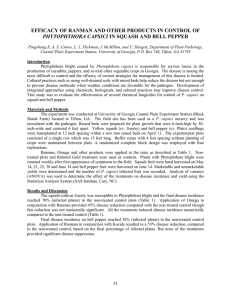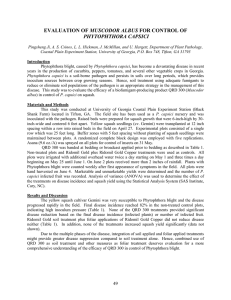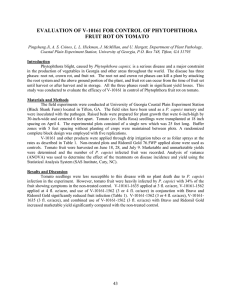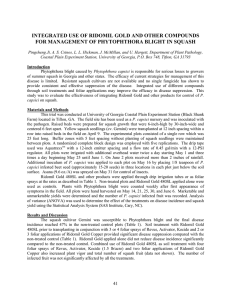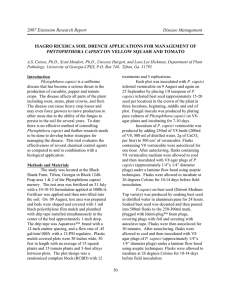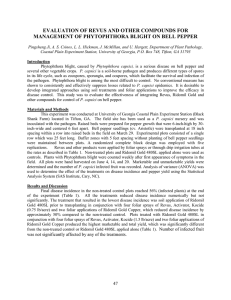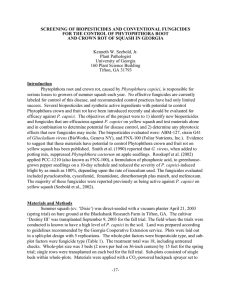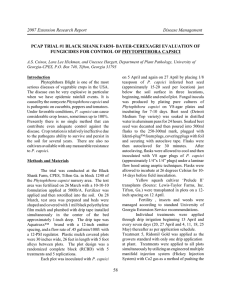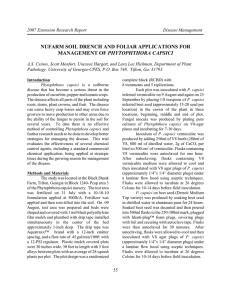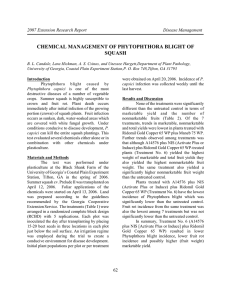EFFICACY OF V-10161 AND OTHER PRODUCTS IN CONTROL OF PHYTOPHTHORA CAPSICI
advertisement
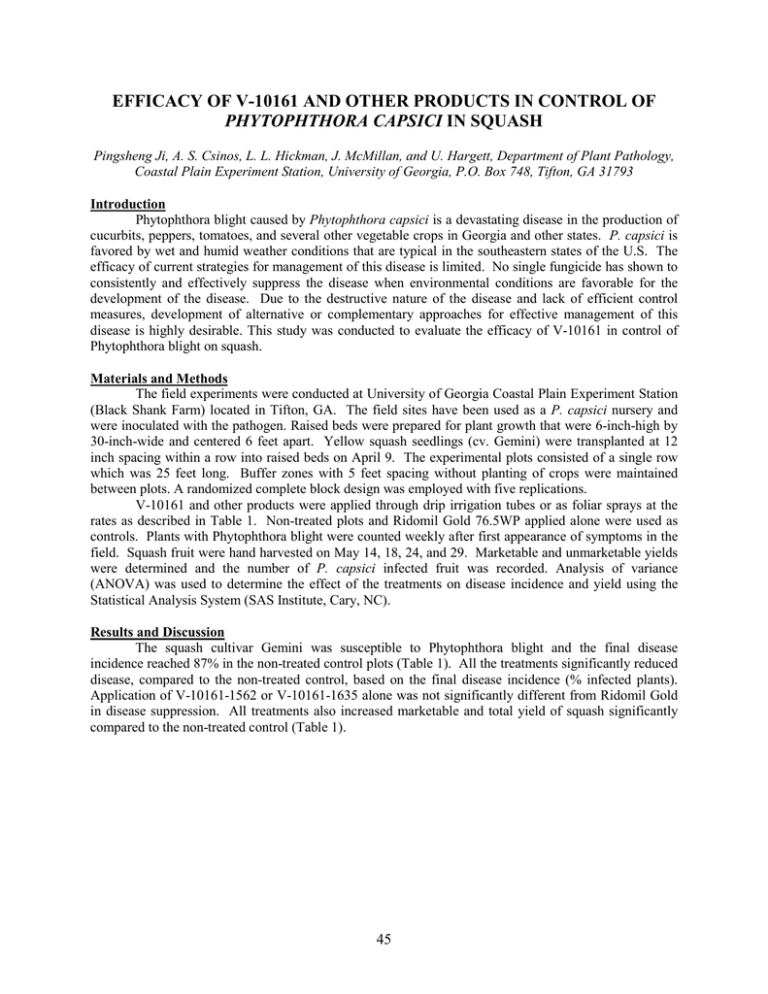
EFFICACY OF V-10161 AND OTHER PRODUCTS IN CONTROL OF PHYTOPHTHORA CAPSICI IN SQUASH Pingsheng Ji, A. S. Csinos, L. L. Hickman, J. McMillan, and U. Hargett, Department of Plant Pathology, Coastal Plain Experiment Station, University of Georgia, P.O. Box 748, Tifton, GA 31793 Introduction Phytophthora blight caused by Phytophthora capsici is a devastating disease in the production of cucurbits, peppers, tomatoes, and several other vegetable crops in Georgia and other states. P. capsici is favored by wet and humid weather conditions that are typical in the southeastern states of the U.S. The efficacy of current strategies for management of this disease is limited. No single fungicide has shown to consistently and effectively suppress the disease when environmental conditions are favorable for the development of the disease. Due to the destructive nature of the disease and lack of efficient control measures, development of alternative or complementary approaches for effective management of this disease is highly desirable. This study was conducted to evaluate the efficacy of V-10161 in control of Phytophthora blight on squash. Materials and Methods The field experiments were conducted at University of Georgia Coastal Plain Experiment Station (Black Shank Farm) located in Tifton, GA. The field sites have been used as a P. capsici nursery and were inoculated with the pathogen. Raised beds were prepared for plant growth that were 6-inch-high by 30-inch-wide and centered 6 feet apart. Yellow squash seedlings (cv. Gemini) were transplanted at 12 inch spacing within a row into raised beds on April 9. The experimental plots consisted of a single row which was 25 feet long. Buffer zones with 5 feet spacing without planting of crops were maintained between plots. A randomized complete block design was employed with five replications. V-10161 and other products were applied through drip irrigation tubes or as foliar sprays at the rates as described in Table 1. Non-treated plots and Ridomil Gold 76.5WP applied alone were used as controls. Plants with Phytophthora blight were counted weekly after first appearance of symptoms in the field. Squash fruit were hand harvested on May 14, 18, 24, and 29. Marketable and unmarketable yields were determined and the number of P. capsici infected fruit was recorded. Analysis of variance (ANOVA) was used to determine the effect of the treatments on disease incidence and yield using the Statistical Analysis System (SAS Institute, Cary, NC). Results and Discussion The squash cultivar Gemini was susceptible to Phytophthora blight and the final disease incidence reached 87% in the non-treated control plots (Table 1). All the treatments significantly reduced disease, compared to the non-treated control, based on the final disease incidence (% infected plants). Application of V-10161-1562 or V-10161-1635 alone was not significantly different from Ridomil Gold in disease suppression. All treatments also increased marketable and total yield of squash significantly compared to the non-treated control (Table 1). 45 Table 1. Efficacy of V-10161 and other compounds in control of Phytophthora blight on squash Yield (lb/A)1 Treatment and rate Disease Marketable Total Infected fruit1,2 Infected plant (%)1,3 Non-treated control 26,708 b 27,851 b 87.0 a V-10161-1562 4.0SC, 2 fl. oz/A 39,449 a 39,858 a 1.4 a 0.0 c V-10161-1562 4.0SC, 3 fl. oz/A 42,226 a 42,716 a 0.2 bc 44.0 b V-10161-1635 4.0SC, 3 fl. oz/A 36,264 a 36,754 a 0.0 c 55.0 b V-10161-1562 4.0SC, 4 fl. oz/A 39,204 a 39,694 a 1.2 ab 49.0 b V-10161-1562 4.0SC, 3 fl. oz/A Bravo 4.17SC, 2.25 pt/A Ridomil Gold 76.5WP, 2 lb/A 39,858 a 40,021 a 0.0 c 49.0 b V-10161-1562 4.0SC, 4 fl. oz/A Bravo 4.17SC, 2.25 pt/A Ridomil Gold 76.5WP, 2 lb/A 37,408 a 37,734 a 0.2 bc 47.0 b Ridomil Gold 76.5WP, 2 lb/A 38,469 a 38,796 a 0.6 abc 47.0 b 1 53.0 b Data are means of five replications. Means within a column followed by the same letter are not significantly different (P = 0.05) according to Duncan’s multiple range test. 2 Number of P. capsici infected fruit each plot. 3 Final disease incidence. 46
